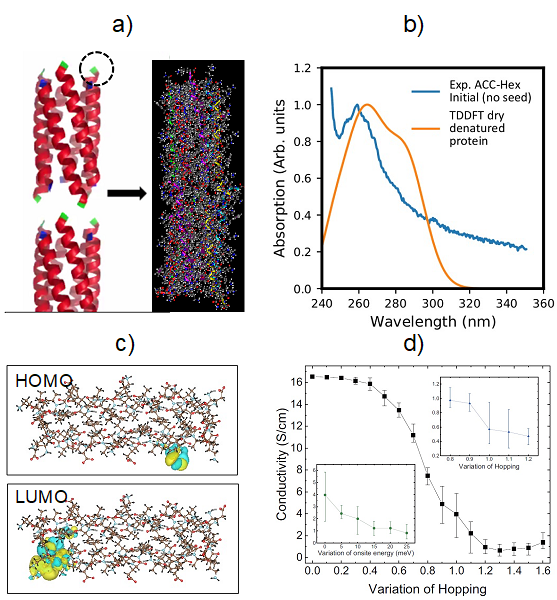2021 IRG-2: Understanding the Unexpected Observed Long-Range Conductivity in Self-Assembled Coiled-Coil Hexamer Peptides
We aim to understand the nature of conductivity along bio-inspired nanowires and tune these properties via change in chemistry that can be achieved synthetically. This year, we studied a hexamer of coiled peptides which has been synthesized and displays efficient conductivity in measurements [1].
We performed molecular dynamics (MD) simulations to determine the structure of hexamers in solution and hexamer pairs (Fig. 1a). Large-scale first-principles density functional theory (DFT) simulations determined the electronic structure of subsystems. We systematically studied the influence of approximations made within DFT and demonstrated accuracy by comparison of optical absorption spectra computed within time-dependent DFT (TDDFT) with experimental measurements on a single peptide (Fig. 1b). We determined that the electrons and holes near the Fermi energy localize (Fig. 1c), suggesting that conductivity occurs via electron hopping. A model of electron hopping was then applied and determined that randomization of electron and energy misalignment between adjacent sites can strongly impact transport (Fig. 1d), indicating an avenue for tuning the transport properties.
[1] N.L. Ing, R.K. Spencer, S.H. Luong, H.D. Nguyen, and A.I. Hochbaum, ACS Nano 2018 12 (3), 2652-2661

D.K. Lewis, Y. Oh, Q. Cao, S. Sharifzadeh (Boston University)
L. Gu, A.I. Hochbaum, R. Wu (University of California, Irvine)
UCI MRSEC 2011967 IRG-2 Sharifzadeh Protein Conductivity.pptx